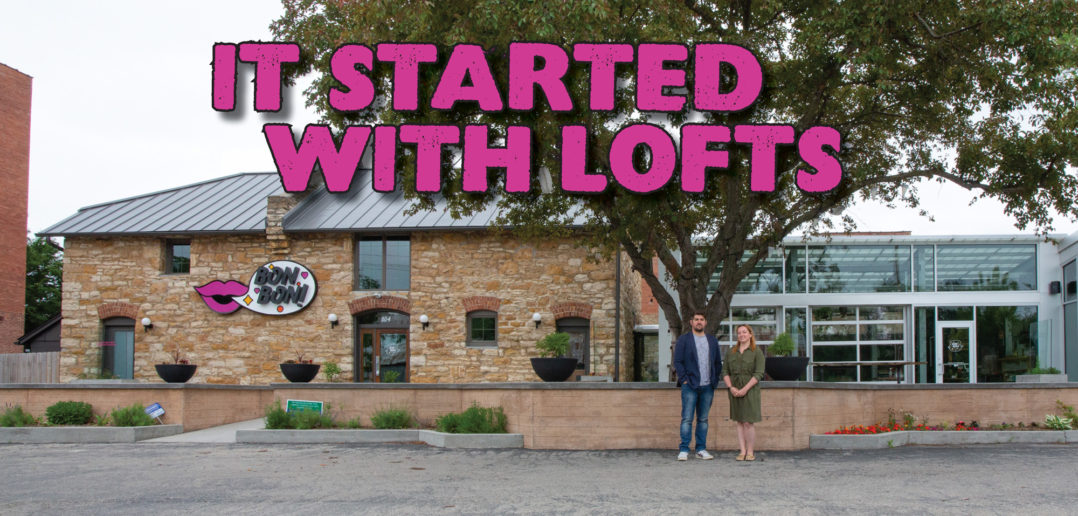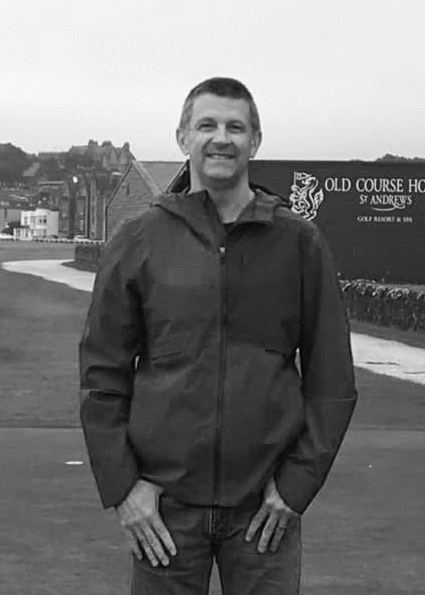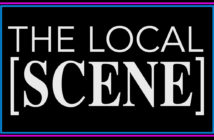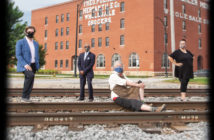East Lawrence’s Warehouse Arts District started with a singular focus on converting one building and blossomed into something so much more.
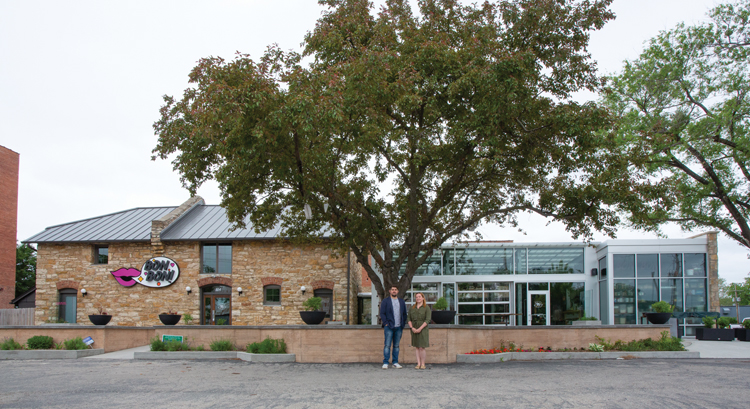
Codi and Simon Bates in front of their restaurant Bon Bon!
When Tony Krsnich was sewing the first seeds of development for a little-regarded area of East Lawrence eight years ago, his visions were more molehill than mountain.He looked at the century-old Poehler Mercantile building down on Pennsylvania Street, between Eighth and Ninth streets, a building that was targeted to be torn down, and thought it might be a good structure to convert into loft apartments. But the idea went no further than that.
“There was no plan or financial capacity to look at creating an arts district,” says Krsnich, president and chief executive officer of Flint Hills Holdings Group. “This was just one building.”
 If we wish to rebuild our cities, we must first rebuild our neighborhoods.
If we wish to rebuild our cities, we must first rebuild our neighborhoods.
–Harvey Milk
Flash forward to today, and an arts and entertainment district is precisely what Krsnich’s original plan has blossomed into. Soon after the Poehler Lofts went in, Krsnich’s second project, the Cider Gallery, a combination art gallery/events space, was created next door. Next door to that, Codi and Simon Bates, owners of the Burger Stand on Massachusetts Street, took an old ammunitions warehouse Krsnich was developing into a restaurant he called Bistro and created Bon Bon, an eatery serving food sourced locally.
Lawrence Beer Company completed the strip of renovated old buildings on Pennsylvania Street years later, and businesses like Repetition Coffee, Decade, Jungle House, Culinaria and Hoke Ley Architects & Design have further enhanced a neighborhood that was known more for industrial- and service-related businesses.
Put together, it’s become known in Lawrence as the Warehouse Arts District. And it’s quickly becoming one of the coolest places in town to hang out, grab a bite or drink and get social.
“It’s really exciting to see the energy that’s been built around here,” says Dalton Paley, a Lawrence artist who owns Art Emergency, which rents working spaces to artists and displays work, in the area. “It’s given people a great place to live, a place to work.
“To me, it’s one of the more exciting places in Lawrence.”

Tony Krsnich stands in the same location as this stone cutting yard located at 9th and Delaware (with the same stone building behind). Eight workers can be seen near pieces of stone which they are shaping with chisels and mauls. Douglas County Historical Society, Watkins Museum of History
A Surprise Hit
Krsnich says he knew something special was happening when he leased all 49 units of the Poehler Lofts within 11 hours of opening.
“Some movers and shakers, along with some old guard, took interest,” he says.
That included George Paley (Dalton’s father), a well-known local artist and businessman who worked with Krsnich on the idea of developing one of the old buildings on Pennsylvania into an art gallery that also could serve as an events space.
“The Cider Gallery came from that,” Krsnich says. “We believed if we got artists involved, people would want to hold high-end events on the first floor.”
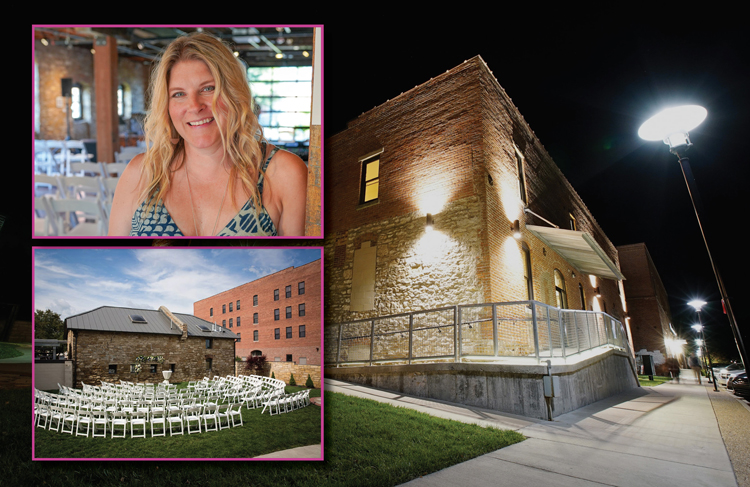
Top Left: Jennifer Burkhead by Jeff Burkhead, Cider Gallery outdoors by Melissa and Beth Photography, Cider Galler at night by Adam Johnson
The Lawrence Arts Center, then under the leadership of Susan Tate, who was its chief executive officer from 2009 to 2016, also got involved in the district’s development. A big part of the center’s mission was to find places where artists could live and work affordably. Tate formed a partnership of ideas with Krsnich and solicited funding from both private foundations and government sources, including ArtPlace America, a foundation that matches funding to help support public art projects.
“When you find a place like the Warehouse Arts District, where city and private parties are investing, it’s the perfect opportunity to form a partnership,” Tate explains. “It targeted money for public art and work spaces, which I think is really important. It’s a fabulous neighborhood with fabulous working-class architecture.”
The Cider Gallery opened in April 2013. In 2014, the space won the National Historical Development of the Year award from the National Trust.
Krsnich developed the second floor of the Cider Gallery into a flexible workspace for entrepreneurs. While some of the space has been broken into separate offices, much is left open for people to work in communal comfort and collaboration.
 Imagine what our real neighborhoods would be like if each of us offered…just one kind work to another person.
Imagine what our real neighborhoods would be like if each of us offered…just one kind work to another person. 
–Fred Rogers
“There are three revenue sources,” Krsnich says. “There’s membership, cubicle rental and standard office rental. We designed it so that, if the cowork space did well, it could carry the rent of the building. If the downstairs did well, it could carry the rent of the building.”
With the Cider Gallery and Poehler Lofts up and running, Krsnich didn’t stop there. He built 9 Del Lofts just south and east of the area—43 units, 80 percent of which are affordable housing. At 716 East Ninth St., he took a 2,000-square-foot building and broke it up into a live/work space called the Annex Building. And in the works are the Penn Street Lofts, going in at Eighth and Pennsylvania streets, across the street west of Bon Bon. The plan there is for 47 units, seven live/work units and an additional 4,600 square feet of commercial/retail space on the first floor. Krsnich predicts more than 100 jobs will be created with that project.
Before all the development, buildings in the district were about 90 percent vacant, he says. Today, it’s close to 100 percent occupancy with hundreds of people on waiting lists to rent a loft or workspace.
“We did all this organically,” Krsnich continues. “Not having a master plan, it’s far exceeded my expectations. All projects have artists in mind, affordable housing in mind. Affordable housing is outstanding, but I’m most proud of the job creation and retention. There were maybe 10 to 15 people working in the area before. Today, there are more than 200.”
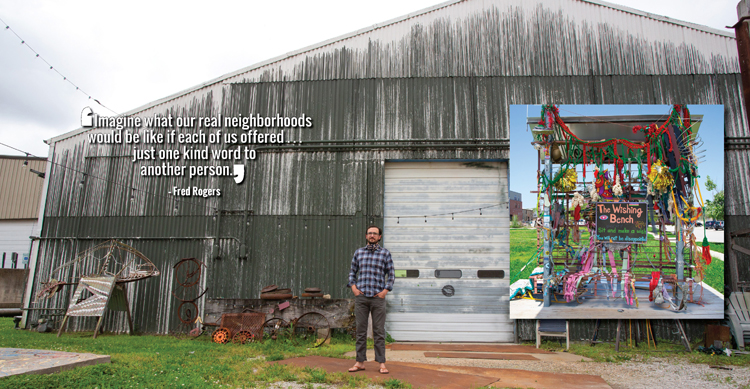
Dalton Paley out font of the Art Emergency building surrounded by sculptures created by his father George. The wishing bench of East Lawrence
Bon Bon Appetit!
Of all the Warehouse Arts District projects he’s been involved in, Krsnich says there’s no project he’s more proud of than Bon Bon and credits his relationship with Codi and Simon Bates for that. In fact, the Bateses later bought the Cider Gallery building from Krsnich.
“If I didn’t find Simon and Codi, I’m not sure what I would’ve done with that space,” he says.
For the Bateses, the development and opening of Bon Bon was a natural, albeit risky, venture. In 2009, the couple purchased a rundown house in East Lawrence near the restaurant. They had lived in the neighborhood nearly 12 years, were raising a 3-year-old daughter and had watched the area slowly develop.
“We worked well with Tony,” says Codi Bates, Bon Bon’s general manager in addition to owner. “We like a challenge. Bon Bon was risky. But, we just fell in love with the space. It was a space comfortable for the community.”
It wasn’t always a comfortable space for a restaurant, however. For the first few years of the business, the kitchen was in a food truck parked adjacent to the property. Dining space was small.
But over the years, those early constraints were remedied. A full kitchen was included with a new addition that also included enclosing an awning previously used for outdoor seating and limited to good-weather evenings. Bon Bon lost its garden across the street, where it sourced much of its produce, to development of Penn Street Lofts, but developed a culinary garden within the restaurant.
“We found our stride this winter,” Bates says.
Another boutique eatery in the area is Culinaria, which has been in the neighborhood for 10 years but only as a dine-in restaurant the last two. Like Bon Bon, it also is a family endeavor. It began as a catering and events business, but as owners Regan Lehman Pillar and Aaron Pillar traveled, they discovered different recipes and foods they wanted to bring to their community.
“It’s difficult catering year-round,” Lehman Pillar says. “The business was moving in different directions from a culinary standpoint, and we found it difficult to take the catering business on that journey. We were looking to shore up business, and the restaurant has become its own entity. It’s taken over the catering side as our main business.”
“As we get busier, we find ourselves drawn to more normal restaurant dining,” Lehman Pillar says.
Like all other service and food industries, the Bateses and Bon Bon, and the Pillars with Culinaria were hit hard this spring by the coronavirus pandemic. The restaurants closed for a time but, like other eateries throughout the country, found survival through online take-out orders, curbside service and patio dining before gradually opening with new public spacing restrictions as imposed by the state.

Matt Williams stands in front of the Lawrence Beer Company at 826 Pennsylvania St. which once was the Kansas Seed House Douglas County Historical Society, Watkins Museum of History Left: above: Truck Festival by Ginger Lobb Photography, Lawrence Beer Company by Guerilla fanfare
“It Was Always Going To Be This Building”
When Matt Williams made the decision to push forward with his dream of creating and owning his own brewery, there was only one building he considered as a possible location. He drove past the old Barteldes Seed Co. building in East Lawrence almost daily as part of his route on a former job. And each day, he gazed at the majestic, 120-year-old brick building and imagined the possibilities.
“I was a regional manager of the top-100 breweries in the Midwest region and performed market visits,” Williams says. “I visited a lot of breweries to see what works. My favorite breweries were always those in the middle of neighborhoods. You could just sit back and watch the neighborhood roll in. When you think about it, all the big breweries started as neighborhood breweries.
“It was always going to be this building, even without all the Warehouse Arts development,” he explains.
The development of the Warehouse Arts District only further enhanced the building and location for Williams. Today, the Lawrence Beer Company, which will celebrate its three-year anniversary this summer, stands as a focal point of the district. The sheer size of the place makes it the most visible among local gathering spots.
“We love it here; it’s perfect for the kind of business we want to have,” Williams says. “There’s kind of an honest, sincere vibe about East Lawrence.”
As Williams was going about the process of designing Lawrence Beer Company, he says he always kept the native characteristics of the neighborhood—the vibe of the place—in mind.
Nowhere is that more evident than in the huge anniversary party the brewery hosts every August. Pennsylvania Street is closed between Eighth and Ninth streets, local food vendors and food trucks are invited in, and at least one big-name band—The Mighty Mighty Bosstones headlined a couple years—is brought in, making for a street festival atmosphere.
“The idea is to make it a tradition,” Williams says, “something people in the neighborhood can be proud of. The whole part of this business was to be a neighborhood gathering spot. I want to make people in the neighborhood feel that this is theirs.”
The vast space inside the main dining room and bar area of Lawrence Beer Company makes it a favorable location for community events. Williams and his partners made sure the brewery also offered a food menu to increase accessibility to families. A spacious patio on the south side and garage doors that can open during nice weather further add to the welcoming community atmosphere.
Business has been so good, Lawrence Beer Company added a second location last October in West Lawrence, off Bob Billings Parkway and Wakarusa Drive.
Williams says one of the most pleasurable experiences with the original brewery in East Lawrence has been the relationships he’s forged with the other restaurant and entertainment establishments in the neighborhood.
Foremost among those relationships is the Cider Gallery, without a doubt the most versatile of entertainment/events businesses in the Warehouse Arts District. The cavernous main floor can serve as a space for weddings and receptions. It hosts fund-raisers. There’s a steady flow of arts exhibits and performances by local artists, highlighted by large events and shows on the city’s Final Fridays (it was the original Final Fridays spot in East Lawrence).
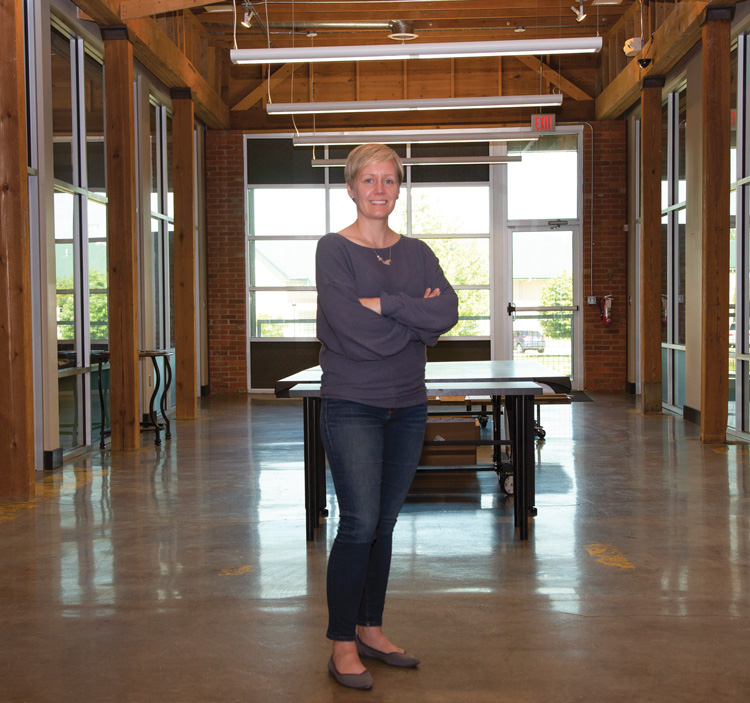
Katie Hoke inside the offi ces of Hoke-Ley Architecture & Design
It also hosts occasional music events, such as a recent “Sinatra Party” to celebrate the birthday of the late entertainer Frank Sinatra.
Jennifer Burkhead, director of the Cider Gallery, also recruits food trucks for the annual Kansas Food Truck Festival, held each May. This year, due to COVID-19 concerns, the festival has been rescheduled to September 13, 2020 (additional information about the event and scheduling can be found at www.ksfoodtruckfest.com). Last year, the festival quickly sold out the 4,300 available tickets and drew more than 5,000 (children younger than 12 get in free), raising $60,000 to $70,000 for Lawrence food pantries.
“That was Tony’s vision,” she says. “It’s a great group of neighbors. It’s a great neighborhood for people working together. Everyone gets along great.”
Like Lawrence Beer Company, which houses 13 apartments above its commercial space, the Cider Gallery has coworking office space on its second floor.
Other businesses have also thrived in the row of old structures that line Pennsylvania Street. Businesses such as Hoke Ley Architecture & Design, which moved into a coworking space that was an old poultry processing warehouse on Pennsylvania three years ago, has ridden the Warehouse Arts District wave ever since.
“When Lawrence Beer Company and Bon Bon opened, you saw the area explode having more people there,” principal/owner Katie Hoke says. “What you can’t put a price tag on are the chance connections you make. I’ve met a number of new clients, professional acquaintances, mentors whom I’ve learned a lot from.”
Hoke Ley employs six and, in addition to commercial and residential architecture and design services, also is a contractor and developer of porchlight homes.
“It’s just a very cool neighborhood,” Hoke says. “It’s a more diverse neighborhood and great mix of high-end and more modest homes.”
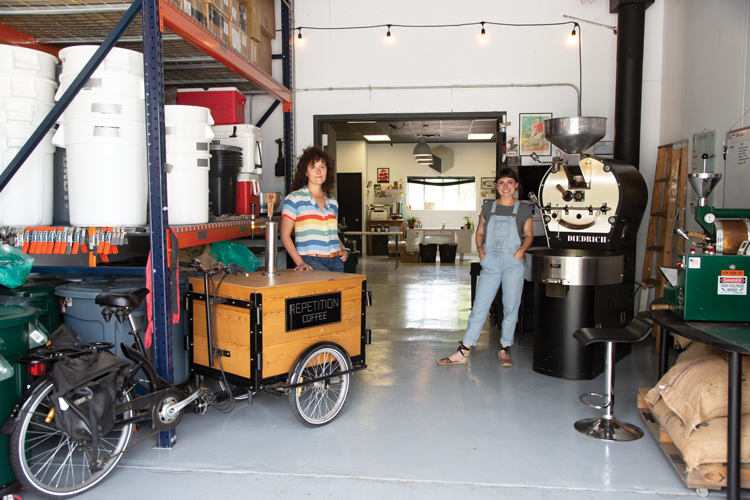
Amy Pope and Siena Vance preparing to roast beans at Repetition Coffee
Java Central
The development of the Warehouse Arts District also has spurred development of small business in surrounding areas, including two popular spots known for brewing and dispensing coffee.
Decade took root six years ago in a nondescript white building at the southeast corner of Ninth and Delaware streets. At the time, the Cider Gallery was about the only other business in the area.
It started as a small coffee shop but over time has “built on things that were right at the time, not everything at once,” explains manager Cody Haynes.
In addition to coffee, Decade serves herbal and traditional teas, wine by the glass, beer and, in fact, has a full bar with featured cocktails. It also serves what the menu refers to as “sustenance”—sandwiches, salads, burritos, rice bowls, etc.
There is space for larger business meetings, and a spacious patio doubles capacity.
“A characteristic of East Lawrence is that it’s always been where the unusual and artsy-type people are,” Haynes says. “But we have a lot of students come in. It’s a mix. It’s an interesting dynamic between morning people and evening people.”

Rachel Guffey sits outside her Jungle House store
Sharing Decade’s patio is Jungle House, a tropical houseplant store that was opened in November 2018 by Rachel and Jhami Guffey to fill a personal need.
“I became addicted to tropical houseplants three years ago, and Lawrence did not have a place,” says Rachel Guffey, who uses the plants to help her with “winter depression.” “I was having to drive to Kansas City all the time to feed that addiction. My husband has a strong entrepreneurial spirit, and I’ve worked a long time in small business, so it wasn’t that stressful.”
The Guffeys utilize Jungle House as a community gathering spot, hosting a variety of workshops and other events for the public. They even keep two chairs in the back of the shop for patrons to come in and relax with a book.
“When we started, I thought we’d just be open a couple days a week, and I’d work here part-time,” Rachel says. “Today, we’re open seven days, and I have a staff of eight.”
Repetition Coffee launched a couple blocks west of Pennsylvania Street, at Ninth and New Jersey streets, in November 2015 and injected an instant dose of hipness to the district with its creation and sales of roasted coffee designed from concoctions owner Amy Pope tasted on her worldwide travels. The business employs four in the modest, two-room building that includes a roasting room and lab.
While Repetition Coffee is strictly a wholesale provider, Pope says she’s been opening up her work space to the public more and more. Right now, she invites the public to come sample her latest creations every third Friday of the month, calling it the “Little Coffee Shop.”
“It’s been a big hit,” she says. “We’re going to make it once a week.”
As Pope puts it, the growth of the Warehouse Arts District has also fueled the desire for a more open atmosphere for the company.
“I think it’s increased visibility,” she says. “As people walk down to Lawrence Beer Company or Bon Bon, they smell the roasting and pop in.”
Pope also has enjoyed the communal aspect of the area. When Repetition Coffee moved in, it gave 5 to 10 pounds of coffee to Decade coffee shop to use for a “throwdown,” when baristas come in and compete for the best latte art. It has also hosted local schoolchildren for coffee classes, and elementary students in the area painted a mural on a side of Repetition’s building.
“There’s a real sense of neighborliness,” Pope says. “We hold each other up.”
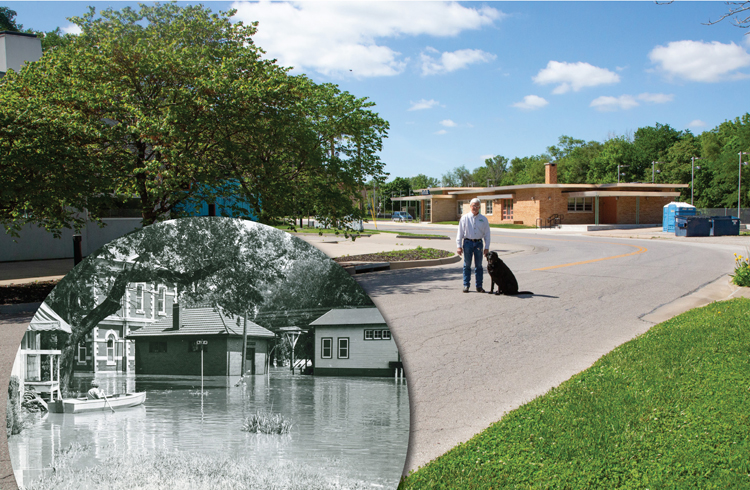
Marty Kennedy of Kennedy Glass stands with his dog where the 1951 fl ood washed out the road across from where Kennedy Glass is today. High water around the Santa Fe station in 1951. Person in row boat at left.Douglas County Historical Society, Watkins Museum of History
Good for the Old Guard
Of course, there were successful companies in the Warehouse Arts District area long before Krsnich first envisioned turning an old building into lofts. It seems as though they, too, have enjoyed the resurgent growth of business in what had long been regarded as an industrial zone.
Kennedy Glass has been in business nearly 70 years and has been at 730 New Jersey St. for 42. And the growth has been especially good to former owner Marty Kennedy. His company was called upon to provide the glass on the remodel of both the Poehler Lofts and Cider Gallery. Then, a little more than a year ago, Krsnich purchased the Kennedy Glass property.
“All the development has been great for the neighborhood,” says Kennedy, who continues to work and keep the business going until he retires.

Maria Preston-Cargill, Senior VP Allen press
And the business that employs the most people—190—in the area is Allen Press, which moved there in 1985 and provides author-to-reader services for scholarly publishers and associates to print, both physical and online. It also offers some marketing, graphic design and associate management services.
“We’ve enjoyed hosting events at the Cider Gallery,” says Maria Preston-Cargill, senior vice president, marketing and client services, with Allen Press. “It’s been a very nice addition. And I think it’s fair to say Allen Press has enjoyed having a coffee shop (Decade) just steps away from our door.
“The character of the entire area just makes our environment nicer,” she adds.
Kennedy, in fact, has lived across the street from Kennedy Glass for longer than the business has been there. So there perhaps is no better arbiter of the progress of the Warehouse Arts District, from both the perspective of business owner and resident.
“It’s great to take nice, peaceful walks in the neighborhood,” he says. “It’s busy during the day, quiet during the evenings. And it’s pretty safe, too.
For more information about what the businesses are doing to safely reopen as well as changing schedules check out their websites:
Allen Press
Bon Bon!
Cider Gallery
Culinaria Mediterranean Kitchen
Decade
Hoke Ley
Jungle House
Kennedy Glass
KS Food Truck Festival
Lawrence Beer Co.
Repetition Coffee
“It’s been a very busy time for the community, but a lot of good businesses have gone in there,” he continues. “I think visitors have enjoyed our eclectic neighborhood.”
More to the point, the success of the Warehouse Arts District further proves the point that folks like Tate, Paley and Burkhead have held all along: Art can be a strong economic driver for a community. Tate says she’s heard from many business owners downtown who say their businesses have been helped because of the proximity to the Lawrence Arts Center, which is at 940 New Hampshire St.
“There is a lot of intangible value to art,” she says. “The Lawrence Arts Center raises $200,000 a year for art classes for young people. That changes lives. You can go back to the 14th century when artists attracted well-to-do patrons in a community. Art attracts people to move to Kansas from major urban centers around the world, people like doctors who are looking for culture in a community.
“We need to keep the mixture alive where artists can continue to live there affordably, and the area would remain as vibrant as it is today,” Tate says.

